Introduction
Syphilis1 (Lues) is an infectious disease caused by Treponema pallidum, which is a small spiral spirochete
Epidemiology
Approximately 60% of those exposed become infected.2 It has gradually increased in incidence with AIDS and IV drug use. In the United States, infection is relatively uncommon, but it is more common in other countries. Routine serological testing is still done in the United States for some populations: pregnant women, military inductees, some hospitalized patients and, in some states, is required for marriage licenses.
Etiology
It is sexually transmitted, except in the congenital form where transmission is in utero or perinatal. Infection with blood products is another possible means of transmission.
Primary Syphilis
About 14 to 28 days (or as much as three months) after exposure to an infected lesion, a small, asymptomatic chancre develops at the point of inoculation. If the chancre is secondarily infected, it can be painful. Syphilis is most infectious at this stage. With no treatment, the lesion heals in 6 to 8 weeks.
Symptoms and clinical features
The patient can present with a small, (a few millimeters to 1-2 cm in size) asymptomatic, firm chancre or with no symptoms at all. Most women are unaware of the primary chancre or the possibility of infection from their partner(s). Lesions may be found extra-genitally, in the mouth, rectum, breasts, etc., as well.
The chancre, usually solitary, starts as a small papule that breaks down into a painless, round or oval, 1 to 2 cm ulcer with a raised sharply demarcated border and little exudate.

The labium majus or vestibule is the most frequent site involved, although cervical, vaginal or clitoral lesions, anal ulcers may occur depending on the portal of entry. Regional lymph nodes are enlarged within one week and may be unilateral.3
Diagnosis
The clinical picture plus serologic testing confirms the diagnosis. A positive dark-field examination of the lesions is diagnostic but this test is rarely available in medical offices today. HIV serology should be done on every patient diagnosed with syphilis, with repeat testing in three months if the first test is negative.4
Differential diagnosis
Syphilis must be considered and ruled out in the diagnosis of any ulcerative anogenital lesion, for example, chancroid, genital herpes, fixed drug eruption, lymphogranuloma venereum, traumatic ulcer, aphthous ulcer, and granuloma inguinale.
Pathology/Laboratory Findings
The Rapid Plasma Reagin (RPR) is positive by the 14th day of the chancre. The Venereal Disease Research Laboratory (VDRL) test does not become reactive that early. The Fluorescent Treponema antibody-absorption test (FTA-ABS) becomes positive at the time of appearance of the chancre and is more specific than the VDRL. Other tests may enhance the ability to diagnose: Treponemal pallidum particle agglutination test (TP-PA), the Treponemal pallidum hemagglutination assay (TP-HA) and Western blot tests. There can be false negatives and false positives with all of the tests.
Biopsy of the genital ulcer, stained with Warthin-Starry silver, demonstrates the spirochetes.
Treatment/management
For penicillin-tolerant patients, prescribe:
- Benzathine penicillin G 2.4 million units IM (1.2 million units per buttock) in a single dose. (It is important to use the correct penicillin: Bicillin L-A, NOT Bicillin C-R in the United States.)5
- For penicillin-allergic patients, the CDC recommends desensitization; when this is not possible, prescribe:
- Doxycycline 100 mg by mouth twice a day x 14 days.
OR - Azithromycin 2 g orally as a single dose, only if absolutely necessary as there have been treatment failures with this medication.6
OR - Tetracycline 500 mg orally 4 x a day x 14 days.
Repeat serology at six and 12 months and a CSF examination if there are any neurologic signs or the patient is HIV positive.
Note: see the CDC STD Treatment Guidelines for the latest opinion on best treatments. (http://www.cdc.gov/std/syphilis/)
The CDC notes that:
The Jarisch-Herxheimer reaction is an acute febrile reac tion frequently accompanied by headache, myalgia, fever, and other symptoms that usually occur within the first 24 hours after the initiation of any therapy for syphilis. Patients should be informed about this possible adverse reaction. The Jarisch-Herxheimer reaction occurs most frequently among patients who have early syphilis, presumably because bacterial burdens are higher during these stages. Antipyretics can be used to manage symptoms, but they have not been proven to prevent this reaction. The Jarisch-Herxheimer reaction might induce early labor or cause fetal distress in pregnant women, but this should not prevent or delay therapy.7
Secondary Syphilis
Most women are unaware of the primary chancre. Secondary syphilis develops about 10 weeks (2 to 6 months) after the primary chancre.
Symptoms and clinical features
In secondary syphilis, the patient presents with flu-like symptoms with headache, sore throat, arthralgias, low-grade fever, and lymphadenopathy. Skin complaints at this stage are rash and hair loss.
The lesions develop slowly and can persist for weeks or months with few symptoms. In order of frequency, the following signs may be observed:
- Maculopapular/papulosquamous and a somewhat psoriasiform rash over the torso, arms, and legs, typically with involvement of the palms and soles.

- An irregular, “moth-eaten” alopecia of the beard, scalp, and eyelashes.
- Moist wart-like papules develop in the vulvar and perianal areas: condylomata lata.

- Mucous patches in the form of grayish white round papules and thin plaques in the mouth and on the vulvar and perianal area.
- Generalized lymphadenopathy usually occurs, some times with pharyngitis, iritis, periostitis, hepato splenomegaly, nephritis, and gastritis.
Diagnosis
A positive dark-field examination of the mucous membrane lesions is diagnostic but this test is rarely available in medical offices today.
Pathology/Laboratory Findings
The RPR and VDRL serology shows high or rising titers. In early secondary syphilis, the tests may be falsely negative (the prozone phenomenon) resulting from a high antigen level. Special dilutional prozone testing needs to be done. If these tests are negative and there remains clinical suspicion, then an FTA-ABS test is required.
Differential diagnosis
Differential diagnosis includes pityriasis rosea, viral exanthem, infectious mononucleosis, psoriasis, tinea corporis and versicolor, scabies, lichen planus, drug reactions, and condyloma acuminata.
Treatment/management
In early secondary syphilis of less than one year’s duration, the treatment is the same as for primary syphilis. (Treatment above).
For latent syphilis of more than 1 year’s duration, prescribe:
- Benzathine penicillin G 2.4 million units IM in a single dose
- Doxycycline 100 mg by mouth twice a day x 4 weeks
The titre of the RPR or VDRL and the clinical symptoms must be followed after treatment to detect treatment failure.
- A CSF examination should be carried out if VDRL is equal to or greater than 1:16 in the latent stage and if there are any neurologic signs. Generally, HIV patients are treated with the same treatment regimen as for primary and secondary syphilis.
HIV patients need careful follow-up for relapse, and all patients with syphilis should be tested for HIV.
Note: see the CDC STD Treatment Guidelines for the latest opinion on best treatments. (http://www.cdc.gov/std/syphilis/, https://www.cdc.gov/std/tg2015/syphilis.htm)
References
- Fisher BK, Margesson, LJ. Genital Skin Disorders: Diagnosis and Treatment. Mosby, Inc., 1998. 142–144.
- Klaus W and Johnson RA. Fitzpatrick’s Color Atlas and synopsis of clinical Dermatology, sixth edition. McGraw Hill Medical, 2009. 921.
- Klaus W and Johnson RA. Fitzpatrick’s Color Atlas and synopsis of clinical Dermatology, sixth edition. McGraw Hill Medical, 2009. 924.
- CDC STD Treatment Guidelines 2010.
- CDC STD Treatment Guidelines 2010.
- CDC STD Treatment Guidelines 2010.
- CDC STD Treatment Guidelines 2010.